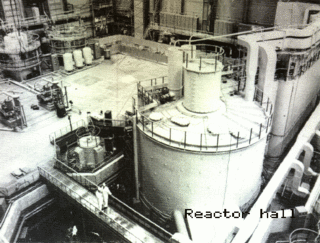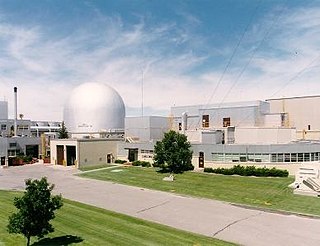This article needs to be updated.(October 2017) |
The Toshiba 4S (Ultra super safe, Small and Simple) is a micro sodium reactor design.
This article needs to be updated.(October 2017) |
The Toshiba 4S (Ultra super safe, Small and Simple) is a micro sodium reactor design.

The plant design is developed by a partnership that includes Toshiba and the Central Research Institute of Electric Power Industry (CRIEPI) of Japan. [1]
The technical specifications of the 4S reactor are unique in the nuclear industry. [2] The actual reactor would be located in a sealed, cylindrical vault 30 m (98 ft) underground, while the building above ground would be 22×16×11 m (72×52.5×36 ft) in size. This power plant is designed to provide 10 megawatts of electrical power with a 50 MW version available in the future. [3]
The 4S is a fast neutron sodium reactor. It uses neutron reflector panels around the perimeter to maintain neutron density. These reflector panels replace complicated control rods, yet keep the ability to shut down the nuclear reaction in case of an emergency. Additionally, the Toshiba 4S utilizes liquid sodium as a coolant, allowing the reactor to operate 200 degrees hotter than if it used water. [ clarification needed ] Although water would readily boil at these temperatures, sodium remains a liquid; the sodium coolant therefore exerts very low pressure on the reactor vessel even at extremely high temperatures. [ citation needed ]
The Toshiba 4S Nuclear Battery was proposed as the power source for the Galena Nuclear Power Plant in Alaska, but the project was abandoned in 2011 and Toshiba did not proceed with an application for certification of the design. [4]
A research team including Allison Macfarlane and Rodney C. Ewing evaluated waste production of a number of small nuclear reactors, including the 4s, and published their findings in Proceedings of the National Academy of Sciences of the United States of America . They found that small modular reactors produce more radioactive waste than conventional reactors. These claims were contested by NuScale Power. [5]

A nuclear reactor is a device used to initiate and control a fission nuclear chain reaction or nuclear fusion reactions. Nuclear reactors are used at nuclear power plants for electricity generation and in nuclear marine propulsion. Heat from nuclear fission is passed to a working fluid, which in turn runs through steam turbines. These either drive a ship's propellers or turn electrical generators' shafts. Nuclear generated steam in principle can be used for industrial process heat or for district heating. Some reactors are used to produce isotopes for medical and industrial use, or for production of weapons-grade plutonium. As of early 2019, the IAEA reports there are 454 nuclear power reactors and 226 nuclear research reactors in operation around the world.

A pressurized water reactor (PWR) is a type of light-water nuclear reactor. PWRs constitute the large majority of the world's nuclear power plants. In a PWR, the primary coolant (water) is pumped under high pressure to the reactor core where it is heated by the energy released by the fission of atoms. The heated, high pressure water then flows to a steam generator, where it transfers its thermal energy to lower pressure water of a secondary system where steam is generated. The steam then drives turbines, which spin an electric generator. In contrast to a boiling water reactor (BWR), pressure in the primary coolant loop prevents the water from boiling within the reactor. All light-water reactors use ordinary water as both coolant and neutron moderator. Most use anywhere from two to four vertically mounted steam generators; VVER reactors use horizontal steam generators.

A breeder reactor is a nuclear reactor that generates more fissile material than it consumes. Breeder reactors achieve this because their neutron economy is high enough to create more fissile fuel than they use, by irradiation of a fertile material, such as uranium-238 or thorium-232, that is loaded into the reactor along with fissile fuel. Breeders were at first found attractive because they made more complete use of uranium fuel than light water reactors, but interest declined after the 1960s as more uranium reserves were found, and new methods of uranium enrichment reduced fuel costs.

A fast-neutron reactor (FNR) or fast-spectrum reactor or simply a fast reactor is a category of nuclear reactor in which the fission chain reaction is sustained by fast neutrons, as opposed to slow thermal neutrons used in thermal-neutron reactors. Such a fast reactor needs no neutron moderator, but requires fuel that is relatively rich in fissile material when compared to that required for a thermal-neutron reactor. Around 20 land based fast reactors have been built, accumulating over 400 reactor years of operation globally. The largest of this was the Superphénix Sodium cooled fast reactor in France that was designed to deliver 1,242 MWe. Fast reactors have been intensely studied since the 1950s, as they provide certain decisive advantages over the existing fleet of water cooled and water moderated reactors. These are:
In nuclear engineering, the void coefficient is a number that can be used to estimate how much the reactivity of a nuclear reactor changes as voids form in the reactor moderator or coolant. Net reactivity in a reactor is the sum total of all these contributions, of which the void coefficient is but one. Reactors in which either the moderator or the coolant is a liquid typically will have a void coefficient value that is either negative or positive. Reactors in which neither the moderator nor the coolant is a liquid will have a void coefficient value equal to zero. It is unclear how the definition of 'void' coefficient applies to reactors in which the moderator/coolant is neither liquid nor gas.

The integral fast reactor is a design for a nuclear reactor using fast neutrons and no neutron moderator. IFR would breed more fuel and is distinguished by a nuclear fuel cycle that uses reprocessing via electrorefining at the reactor site.

A molten salt reactor (MSR) is a class of nuclear fission reactor in which the primary nuclear reactor coolant and/or the fuel is a molten salt mixture. Only two MSRs have ever operated, both research reactors in the United States. The 1950's Aircraft Reactor Experiment was primarily motivated by the compact size that the technique offers, while the 1960's Molten-Salt Reactor Experiment aimed to prove the concept of a nuclear power plant which implements a thorium fuel cycle in a breeder reactor. Increased research into Generation IV reactor designs began to renew interest in the technology, with multiple nations having projects, and as of September 2021, China is on the verge of starting its TMSR-LF1 thorium MSR.

A reactor pressure vessel (RPV) in a nuclear power plant is the pressure vessel containing the nuclear reactor coolant, core shroud, and the reactor core.
Generation IV reactors are six nuclear reactor designs recognized by the Generation IV International Forum. The designs target improved safety, sustainability, efficiency, and cost.

The lead-cooled fast reactor is a nuclear reactor design that features a fast neutron spectrum and molten lead or lead-bismuth eutectic coolant. Molten lead or lead-bismuth eutectic can be used as the primary coolant because especially lead, and to a lesser degree bismuth have low neutron absorption and relatively low melting points. Neutrons are slowed less by interaction with these heavy nuclei and therefore, help make this type of reactor a fast-neutron reactor. In simple terms, if a neutron hits a particle with a similar mass, it tends to lose kinetic energy. In contrast, if it hits a much heavier atom such as lead, the neutron will "bounce off" without losing this energy. The coolant does, however, serve as a neutron reflector, returning some escaping neutrons to the core. Fuel designs being explored for this reactor scheme include fertile uranium as a metal, metal oxide or metal nitride. Smaller capacity lead-cooled fast reactors can be cooled by natural convection, while larger designs use forced circulation in normal power operation, but will employ natural circulation emergency cooling. No operator interference is required, nor pumping of any kind to cool the residual heat of the reactor after shutdown. The reactor outlet coolant temperature is typically in the range of 500 to 600 °C, possibly ranging over 800 °C with advanced materials for later designs. Temperatures higher than 800 °C are theoretically high enough to support thermochemical production of hydrogen through the sulfur-iodine cycle, although this has not been demonstrated.

A sodium-cooled fast reactor is a fast neutron reactor cooled by liquid sodium.

The BN-600 reactor is a sodium-cooled fast breeder reactor, built at the Beloyarsk Nuclear Power Station, in Zarechny, Sverdlovsk Oblast, Russia. Designed to generate electrical power of 600 MW in total, the plant dispatches 560 MW to the Middle Urals power grid. It has been in operation since 1980 and represents an evolution on the preceding BN-350 reactor. In 2014, its larger sister reactor, the BN-800 reactor began operation.
A liquid metal cooled nuclear reactor, liquid metal fast reactor or LMFR is an advanced type of nuclear reactor where the primary coolant is a liquid metal. Liquid metal cooled reactors were first adapted for nuclear submarine use and have been studied for power generation applications.
Lead-Bismuth Eutectic or LBE is a eutectic alloy of lead and bismuth used as a coolant in some nuclear reactors, and is a proposed coolant for the lead-cooled fast reactor, part of the Generation IV reactor initiative. It has a melting point of 123.5 °C/255.3 °F and a boiling point of 1,670 °C/3,038 °F.

The liquid fluoride thorium reactor is a type of molten salt reactor. LFTRs use the thorium fuel cycle with a fluoride-based, molten, liquid salt for fuel. In a typical design, the liquid is pumped between a critical core and an external heat exchanger where the heat is transferred to a nonradioactive secondary salt. The secondary salt then transfers its heat to a steam turbine or closed-cycle gas turbine.

TerraPower is an American nuclear reactor design and development engineering company headquartered in Bellevue, Washington. TerraPower is developing a class of nuclear fast reactors termed traveling wave reactors (TWR).

Small modular reactors (SMRs) are nuclear fission reactors that are smaller than conventional nuclear reactors. They can be constructed in one location and shipped to the site where they will operate. They typically have an electrical power output of less than 300 MWe (electric) or a less than 1000 MWth (thermal). Many SMRs rely on a manufacturing-centric model, the requirement for many deployments to secure to large economies of unit production necessary to achieve economic viability. Some SMRs, typically those using Generation IV technologies, secure additional economic advantage and in some case large, through improvements in electrical generating efficiency from much higher temperature steam generation.
The RAPID-L, RAPID-LAT is a micro nuclear reactor concept conceived as a powerhouse for colonies on the Moon and Mars. It is based on the RAPID-series fast breeder reactor using a liquid lithium-6 design. The study was funded by the Japan Atomic Energy Research Institute (JAERI) in FY 1999-2001. The research was carried out by Japan's Central Research Institute of Electric Power Industry (CRIEPI), Komae Research Laboratory.
The BREST reactor is a Russian concept of lead-cooled fast reactor aiming to the standards of a generation IV reactor. Two designs are planned, the BREST-300 and the BREST-1200. Main characteristics of the BREST reactor are passive safety and a closed fuel cycle.